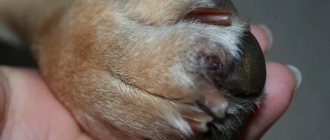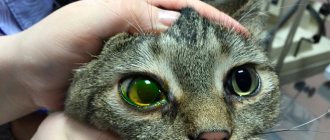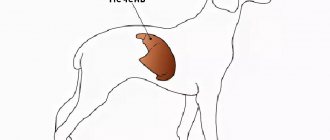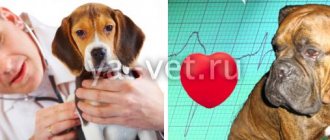My dog has a hard lump under his eye - what is it?
My dog has a hard lump under his eye - what is it?
The owner of the dog should be alert to bumps that appear near the eye or directly on the eyelid, since, most often, they signal that the dog has some kind of ophthalmological pathology.
The reasons why a lump appears under or above a dog’s eye can be very different:
An injury that results in swelling in the eye area.
Violation of the integrity of the skin and penetration of pathological microorganisms.
Insect or snake bites.
As we can see from the list above, a lump on a dog’s eye can be of a very serious nature, so if the tumor does not decrease within 2-3 days, you need to take your dog to the veterinarian!
Swelling of the eyes. Causes
When a dog has a swollen eye, the cause could be something that can be easily fixed or a serious health problem. The most common factors are:
- conjunctivitis. More than half of the cases when a dog has a swollen eye occur precisely
for this disease. Whether the upper eyelid is swollen or the lower eyelid is swollen, the owner needs to carefully examine his pet’s organ of vision. Even if the owner has no idea about basic concepts in veterinary medicine, conjunctivitis cannot be confused with anything. The mild form looks like a constantly flowing tear. On the dog's face, from the corners of the eyes to the mouth, non-drying tracks of copious discharge are formed. In addition to an increase in size, the lower and upper eyelids show signs of redness. Advanced conjunctivitis is expressed in copious discharge of exudate. - allergic reaction. Unfortunately, not only people, but also dogs are familiar with allergies first hand. If the owner knows about this predisposition of his pet, it will not be difficult for him to control the manifestation of allergies. For those who are not yet familiar with this reaction of the body to external irritants, you should pay attention to other symptoms characteristic of allergies. It is impossible to diagnose a dog with an allergy solely on the basis that its eyelid is swollen. In addition to swollen eyes, the classic signs of an allergy are heavy, watery discharge from the eyes and nose.
- inversion and inversion of the eyelid. A swollen eyelid has an unsightly appearance. It turns towards the pupil or vice versa. Accordingly, the outer part of the eyelid with eyelashes, hair and skin rubs against the cornea. The eyes become inflamed, swollen, red and purulent. But this disease does not appear just like that. Entropion is a pathology to which some dog breeds are prone.
- blepharitis. All kinds of injuries, both mechanical and chemical; infections of bacterial origin, infection with subcutaneous mites, diabetes mellitus and problems with the endocrine system can begin the inflammatory process. Which in turn lead to the above-mentioned conjunctivitis.
- foreign objects. Specks of dust and debris lodged in the eye cause itching and burning. Provoke swelling of the eyelid. The dog is uncomfortable, so in an attempt to relieve the itching, it additionally scratches the already inflamed eyelid with its paw.
Don't discount possible insect bites. Bees, wasps, and bumblebees are capable of causing not only eye swelling with their stings, but also distortion of the entire muzzle.
Few people remember heart or kidney disease if their eye is swollen. However, disruptions in the functioning of these organs provoke swelling. First of all, the increase in size occurs in the eyes and ears.
What types of bumps are there?
Veterinarians divide all tumors in a dog's eye into benign and malignant. The appearance of benign lumps can be caused by:
A bruise that the dog received while playing, fighting, unsuccessfully jumping, etc.
Papilloma in the eye area, formed when an animal is infected with the Papillomaviridae virus. In this case, the tumor looks like a dense lump or multi-layered wart.
An abscess in the eye area that occurs as a result of the penetration of bacteria into microcracks in the skin, after which inflammation begins. The dog’s temperature rises, and pus is actively forming inside the abscess. Later, the purulent capsule located under the skin may open, forming a fistula.
Impetigo is diagnosed in puppies under one year of age and is a lesion of the deep layers of the skin by staphylococcus bacteria. In this case, dense subcutaneous bumps of a pinkish color are formed, which subsequently burst and turn into a weeping ulcer.
A cyst can appear on any part of the body, including near the eye and, most often, looks like a hard lump that is easily displaced relative to the skin.
A viral infection causes a dog to develop stye. The internal barley looks like a small ball under the skin of the upper or lower eyelid, and the external barley looks like a purulent lump on the eyelash growth area. With barley, the skin around the eye is red and swollen.
An insect or snake bite to the muzzle can also cause swelling in the eye area.
All of the above pathologies are treatable. A lump under a dog’s eye will disappear without a trace with timely diagnosis and properly selected therapy.
The situation is worse if it turns out that the tumor under your pet’s eye has signs of malignancy. Such a tumor can metastasize throughout the body and kill the dog. This is why any lump that does not go away on its own should be carefully examined by a veterinarian.
Classification
As in humans, abscesses can be characterized by different locations and characteristics of the inflammatory process. So, they are:
- External, superficial (on the ear), internal or deep.
Accordingly, they can be on the skin, in the deeper subcutaneous layers, under the skin itself (in the muscles), or even in the internal organs.
- Benign and malignant.
In the first case, the pus is thick, resembles sour cream in consistency, the boundaries of the abscess are clearly defined (an abscess in a dog after an injection). If it is malignant, then the exudate is liquid and watery. The localization is poorly expressed, there are no clear boundaries of the pathology, the affected tissue is slightly swollen and hot.
- "Hot" and "cold".
The first are external, superficial abscesses, with a well-defined demarcation line, inside - thick, “high-quality” pus. Cold - fuzzy, long-maturing abscesses. Most often they form in the deep layers of the skin and subcutaneous tissue.
What should you do if your dog has a lump?
If you find a lump in your pet's eye area, don't panic. First, try to examine and feel it yourself to understand whether the swelling is a consequence of a bruise or an insect bite, but if this process causes discomfort to the dog, then stop examining. You can postpone the visit to the veterinarian for a couple of days to see how events will develop further and whether the swelling will disappear without the intervention of a specialist.
If the tumor greatly bothers the dog, hurts and increases in size, then take the animal to the veterinarian immediately. At the clinic, the doctor will examine the dog and, if necessary, prescribe a series of clinical tests, a CT scan, or a study of cells taken from the tumor. Only after summarizing all the information received will the veterinarian be able to develop the correct treatment plan for your pet.
Any lump, inflammation or ulcer should be a signal for the dog owner that the four-legged pet needs to spend more time and find out the cause of this problem!
A cyst can appear on any part of the body, including near the eye and, most often, looks like a hard lump that is easily displaced relative to the skin.
How to help your dog before visiting the veterinarian
Of course, there can be no talk of any independent treatment of diseases associated with the organs of vision. But if the swelling of the pet’s eyes obviously has a traumatic, allergic or acute infectious, but at the same time completely understandable nature (for example, after suffering from a cold, the dog showed signs of conjunctivitis), providing first aid to the animal at home is quite acceptable. Moreover, such measures are quite enough for the animal’s condition to quickly stabilize and in this case it is not at all necessary to contact a veterinarian.
Important! Almost the only way to combat inflammation of the eyelids in a dog without establishing an accurate diagnosis is to wash the eyes with clean water, heated to a warm state. Any eye drops, antiseptics or folk remedies can cause burns, allergies or other negative consequences.
The washing procedure is carried out using a cotton pad, and you need to take a fresh one for each eye. During the manipulation, be sure to soak and remove any discharge from the eyes; this will help prevent the eyelids from sticking together and alleviate the animal’s condition.
To quickly relieve an allergy attack, a single use of antihistamines is permissible (for example, Suprastin - at the rate of 1 mg per 1 kg of weight), however, if the swelling does not subside, it is better to consult a specialist for diagnosis and selection of the appropriate drug.
What types of subcutaneous bumps are there on a dog’s body?
All lumps that occur in a pet are divided into two categories - cancerous and non-cancerous formations.
Non-cancerous:
- Papillomas. Typical for smooth-haired dogs. They appear as a result of a viral infection entering the body. They are not dangerous and painless in themselves, so a visit to the doctor can be a preventive measure.
- Cyst. Swelling can be detected quite by accident. This formation does not pose a threat to the life of the pet.
- Hematomas. Such lumps most often occur in the period after surgery, when blood vessels are affected. A large accumulation of fluid can lead to a lump. They are extremely rarely accompanied by pain.
- Abscess. If the animal receives a puncture wound or is stung by an insect, then there is a possibility of bacteria entering, which leads to the formation of a lump-like seal.
Cancerous:
- Benign tumors. Such formations do not metastasize, but only increase in size. They do not threaten the dog's life, but are often removed.
- Tumors of a malignant nature. They actively affect nearby tissues and are characterized by metastases. Advanced cases cause a breakthrough in the dermis, which leads to severe bleeding. Malignant tumors are life-threatening and therefore require urgent removal.
What to do if a lump appears on your dog's back
The lump begins to increase in size, bothers the pet, or there are several of them - these are the first signals that you should not put off a visit to a specialist. The veterinarian must identify the origin of the formation, and then prescribe treatment or surgery. The formation is diagnosed by a whole range of studies (biopsy, tomography, radiography, smear).
The main thing that every owner should pay attention to is that the formation does not fester, does not change color and does not cause pain to the animal. Observations should be carried out over several days; if the compaction does not decrease, it is better to make an appointment with the veterinarian. Please note, in order not to provoke the appearance of a granuloma, it is worth limiting the animal from licking the seal, so it is better to cover it with a band-aid.
To get an idea of what such formations look like, you can watch a video where animals are diagnosed with subcutaneous lumps at an appointment with a veterinarian.
The lump begins to increase in size, bothers the pet, or there are several of them - these are the first signals that you should not put off a visit to a specialist. The veterinarian must identify the origin of the formation, and then prescribe treatment or surgery. The formation is diagnosed by a whole range of studies (biopsy, tomography, radiography, smear).
Causes and types of barley in dogs
The outer side of the eyelids is dotted with exposed sebaceous glands of the mucous membrane. The main function of the glands is to produce lubricant to moisturize the eyeball. The mucous membranes are surrounded by eyelashes, which protect the eyes from microscopic dust particles. If air pressure or dust gets on the eyelashes, the sensory signal is transmitted to the brain and the eyelid closes and the eye begins to water.
Barley is an inflammatory process that began due to harmful microorganisms entering the pores of the sebaceous gland or eyelash follicle. A compaction in the form of a small ball forms on the eyelid. According to localization, barley is divided into:
- External - stye is located on the upper or lower eyelid, while the eye itself swells.
- Internal - stye forms on the inside of the eyelid, and a small painful bump appears on the skin.
The size of the formation depends on the degree of infection and the state of the dog’s immunity. Usually, the process begins with a formation the size of a grain of millet, but can increase, see photo below. Rapidly multiplying microbes “trigger” purulent inflammation, which leads to thinning of the walls of the eyelid and subsequent opening or resorption of the stye.
Typically, the cause of inflammation of the eyelids can be any factor that weakens the immune defense:
- Previous infectious or cold disease.
- Fungal skin infection.
- Intoxication.
- Inflammatory processes of the mucous membrane of the eye, conjunctivitis.
- Violation of animal welfare standards, hypothermia, high dampness in the home, unbalanced nutrition.
- Lack of vitamins.
- Eye injury.
- Stress.
Important! Due to high infection, the inflammatory process can spread to nearby tissues of the eyes and eyelids.
The main causes of the disease
Inflammation of the eye in a dog appears as a reaction to the introduction of various irritants or infections. It can be localized in the inner or outer corners, on the eyelids or in the sclera area. Each disease has its own localization area.
Conjunctivitis
The main cause of puffy eyes is inflammation of the conjunctiva (the mucous membrane of the eye). Conjunctivitis can have different etiologies: infectious, allergic, traumatic. May occur due to exposure to chemical irritants. Sometimes this is a simple violation of eye hygiene, and sometimes this is a complication of internal ailments. Depending on the cause, treatment tactics are also suggested.
In addition to severe swelling of the mucous membrane, conjunctivitis has other symptoms: pain in the eyes, fear of bright light, hyperemia and lacrimation.
If inflammation is not immediately treated, it can develop into a protracted chronic form, when periods of remission alternate with periods of exacerbation.
This form is much more difficult to treat and it is better not to reach it.
Treatment consists of washing the eye with special antiseptic solutions and instilling anti-inflammatory and antimicrobial drugs.
Entropion of the eyelids
With this pathology, part of the eyelid turns inward, towards the pupil, causing the prickly hairs to begin to rub against the surface of the cornea, injuring it. Over time, severe inflammation occurs, which may be accompanied by ulceration of the cornea. If the cornea is involved in the inflammatory process, a complication begins - traumatic keratitis.
Other symptoms of bloat include severe pain, fear of light, and constant lacrimation.
The disease may be hereditary. It is a breed characteristic for dogs with a short muzzle and folded skin (bulldogs, sharpeis). Great Danes also often suffer from bloat, since their eyelid ligaments are genetically weakened.
Symptomatic anti-inflammatory drugs are used as therapy. But only surgery can completely solve the problem.
Blepharitis
Blepharitis is acute swelling of the eyelids. This is a fairly common pathology. First, the outer eyelid is affected, then the process moves to the inner layers of the epidermis, the mucous membrane and affects the conjunctiva. The cause may be internal infections, allergic reactions or genetic disorders. The most susceptible breeds are: Labradors, poodles, English bulldogs, Pekingese and some others.
Depending on the symptoms, scaly, ulcerative, meibomian, and furunculous forms of blepharitis in dogs are distinguished. Treatment is mostly conservative. The dog is prescribed anti-inflammatory and antimicrobial drugs.
Neoplasms
Malignant or benign neoplasms in the eye area are a more serious disease. Older dogs are more susceptible to it. Usually the pathology affects one eye. Initial symptoms may resemble a slowly developing eyelid abscess.
A positive outcome of the disease depends on early diagnosis and timely treatment. In this case, only surgery is effective. To save a dog's life, it is often necessary to remove the affected eye. In case of a malignant process, chemotherapy is additionally prescribed.
Foreign body in the eye
The cause of severe inflammation of the eyes is injury to the cornea by foreign bodies entering the mucous membrane. Motes, midges, small seeds stick to it, mechanically affecting its surface. The dog constantly rubs his eyes with his paw, further infecting the mucous membrane.
It is important to remove the traumatic object as soon as possible to avoid the spread of infection. To perform the manipulation, make any prophylactic solution for washing the eyes (chamomile decoction, strong tea leaves, boric acid solution). Holding the dog's head, spread its eyelids as far as possible and carefully remove the object with a cotton pad soaked in the solution. At the end of the procedure, the eyes are washed generously and an anti-inflammatory agent is instilled.
Allergic eye reaction
If your eyes, ears, or bridge of the nose are swollen, there is a high probability of a severe allergic reaction. The immune system responds to the presence of an allergen in the body by producing a special hormone - histamine. If left untreated, the situation worsens, inflammation increases, spreading to internal organs and systems.
In severe cases, anaphylactic shock and suffocation may develop. There is only one treatment tactic for such a disease - immediate identification of the allergen, removal of it from the body and administration of antihistamines to alleviate the animal’s condition.
Pathologies of the heart or kidneys
Morning swelling of the eyes may indicate heart or kidney disease. Their poor performance indicates impaired blood circulation and causes stagnation of fluid in the body, which is the cause of edema. The eyes may become swollen if the animal receives too much salt. The presence of a large amount of salt in the body can provoke a rise in blood pressure.
Insect bites
In the summer, common causes of edema include bites from poisonous snakes and insects. Bites from mosquitoes, bees or wasps are not fatal and go away on their own over time (in the absence of allergies), while bites from poisonous snakes and spiders can be costly for the dog and its owner.
So, if there is any doubt about which insect showed aggression, you should take the dog to the veterinarian to avoid possible serious consequences.
Treatment and prevention of barley in dogs
Before treating barley, it is necessary to exclude all factors that provoke a decrease in immunity. Next, it is necessary to alleviate the dog’s condition. Classic treatment consists of maintaining hygiene and using anti-inflammatory ointments, for example, Tetracycline, Hydrocortisone, Erythromycin.
We recommend reading: Worms In Cats Treatment Photo
Tetracycline ointment is applied in small quantities to the affected eyelid 5-6 times a day. If the stye is external, the eyelids are treated with Hydrocortisone. Please note that local treatment is carried out for two eyes at once, regardless of the location of the inflammation. To enhance the effect, antibiotics are used - Levomycytin eye drops, used as prescribed by a veterinarian or according to instructions. The course of treatment is 7–14 days. If a stye in a dog’s eye does not go away, take your dog to the doctor. Visually, stye looks like an inflammatory process due to ingrown eyelashes.
Important! Do not heat barley unless the procedure is prescribed by a veterinarian!
At the stage when a purulent head has appeared at the top of the stye, the veterinarian may prescribe heating. Typically, a peeled boiled egg or a warm tea bag is used. You may come across a recommendation to treat barley with 70° medical alcohol, but using the method is much riskier than the possible positive effect.
If styes occur en masse on your dog’s eyelids, be sure to contact your veterinarian, who will determine how to treat the disease. Most likely, local treatment will be powerless, and the animal will be prescribed a course of antibiotics, immunostimulants, followed by surgical opening of the formations.
Important! Never open or squeeze a stye on your dog's eye! In 9 cases out of 10, such self-medication leads to the outpouring of pus into the interstitial space, which is fraught with severe inflammation of the mucous membrane of the eye.
Barley is an inflammatory process that began due to harmful microorganisms entering the pores of the sebaceous gland or eyelash follicle. A compaction in the form of a small ball forms on the eyelid. According to localization, barley is divided into:
Treatment
Experienced breeders know what to do in such situations. Beginners still have to master the technique of providing first aid to their pet. Basic therapy takes into account the cause of swelling.
But there are also general rules that are worth taking into account:
- the dog should not be allowed to put its paws in its eyes - for this purpose a special collar is put on the animal;
- swollen, watery eyes should be washed with cooled boiled water;
- A compress helps reduce swelling: tie a plastic bottle or heating pad filled with cold water to the dog’s eye;
- Provide your pet with plenty of fluids.
If there is a suspicion of an allergy, the dog’s diet is reduced to a minimum. In all cases, treatment of swelling should be comprehensive, when medications are combined with traditional medicine.
Medications
Medicines will be needed when swelling is caused by an allergic reaction. Antihistamines can also be used in the form of drops. But before putting drops in your dog’s eyes, the product must be diluted with water.
Inflamed conjunctiva is treated not only with Levomycetin; other antibiotics (Kanamitsit or Erythromycin) can also be used. Ophthalmic ointments and drops help well.
To alleviate the animal’s condition, it is recommended to apply Tetracycline ointment behind the eyelids and distribute it over the eye membrane. The procedure is carried out at least 5 times a day until the swelling subsides.
You can also instill a solution of Novocaine (2%) or Lidocaine into your eyes. But using local anesthetic for more than 5 days is not recommended.
If your dog has a dry, hot nose, you will need an antipyretic (Carprofen, Vedaprofen). It is given once a day, administered orally. The dosage is calculated taking into account the pet’s body weight.
Traditional medicine
At home, folk recipes are used to treat conjunctivitis.
The animal's eyes are washed several times a day:
- furatsilin solution;
- herbal decoctions (chamomile, rosemary, calendula);
- special lotion.
First, the procedure uses a clean soft cloth to remove all dirt from the muzzle, then moisten a cotton pad with warm water and gently wipe the dog’s eyes, moving from the outer corner to the inner.
Non-cancerous and oncological types of bumps in dogs
A lump in a dog that is not associated with cancer can appear for various reasons:
- injuries;
- vascular damage during surgery;
- mechanical damage to the skin;
- inflammation of the sebaceous glands;
- changes in hair follicles;
- viral infections.
Tumors can appear under the skin, then they are clearly visible. Sometimes formations grow in soft tissues and palpation is required to detect them. All non-cancerous formations can be treated well, the main thing is to show the animal to the veterinarian in time.
A large abscess can occur in any part of the body. Local inflammation is caused by pyogenic bacterial pathogens. An abscess appears in the area of an open wound, bite, or puncture.
There are two types - superficial and deep. A superficial abscess forms in the subcutaneous layer, where tissues swell and swell, and pus accumulates locally. The deep process penetrates under the mucous membranes, sometimes into the internal organs.
A lump near the tail in the anus occurs due to inflammation of the perianal glands. An infection sets in, the area swells, and a foul odor appears.
The tumor on the paw grows right before our eyes, and after 3 days it becomes loose. The dog is lethargic, weak, and does not eat well. The temperature is rising, it is clear that she is worried about painful sensations.
Warts and papillomas
A common occurrence for smooth-haired breeds of pets. One of the reasons for the appearance is DNA viruses. The disease does not appear immediately after contact with an infected animal.
New growths can grow either singly or crowded. Papillomas resemble cauliflower in appearance. The same branched structures and darkish color. The consistency is soft and loose. Their favorite place is the muzzle and oral cavity, as dogs love to lick themselves. Often papillomas appear near the eyes.
On the mucous membranes of the mouth they are found in the area:
They can often be seen in the paws, armpits and groin areas, where they are less contagious. Bleeding from a papilloma is an unfavorable sign; the dog should definitely be shown to a veterinarian to avoid malignancy.
Warts on the neck, paws, and abdomen have a smooth surface and resemble a nodule-like formation. Color varies from pink-raspberry to dark burgundy or brown.
The cause of the appearance is rupture of blood vessels, accumulation of excess fluid after surgery. Hemorrhages occur more often in the ear area due to injuries, scratching, and blows with paws. The more damaged the vessel, the larger the lump grows.
Under the thin skin of the ear, the swelling quickly increases in size. It looks like a heating pad or pillow. It can cause significant discomfort and surgical intervention is required if pus accumulates.
If swelling appears on the paw, it may be a hematoma due to ligament rupture, muscle or tendon damage. The temperature rises locally, and sometimes the lymph nodes become enlarged. A lump after surgery may occur if the dog licked or scratched the stitches.
The cyst-like lump can occur anywhere, in any part of the body. The reason is compression of the gland ducts or blockage. It is often discovered accidentally during a regular examination. A skin cyst has a number of characteristic signs:
- localized in the upper layer of the skin;
- has a round shape;
- upon palpation, soft and loose to the touch;
- usually painless;
- sizes about the size of a pea and up to 5 cm in diameter.
We recommend reading: Retriever's wax and redness running
The cyst between the toes looks like reddish abscesses that the animal constantly tries to lick. In the oral cavity, the formation invades the salivary glands and can be localized under the tongue, in the parotid region.
A typical disease for puppies under 4 months of age, accompanied by itching and purulent discharge. The most vulnerable breeds are boxer, sharpei, and chihuahua.
Scientists have not yet figured out the exact reasons. The root cause is considered to be reduced immunity. The bumps appear suddenly, quickly spread throughout the body, and quickly fester.
Swelling may appear on the head, especially near the eyes. In bulldogs, the “favorite” place is on the face in the folds, in large dogs - in the area of the gonads, on the sides, back.
The disease is complicated by the appearance of fistulas and boils, which develop into a deep form of pyoderma.
Video “What dog owners need to know about cancer”
In this video, experts will talk about cancer in dogs.
Because of the fur, it is not always easy to notice a tumor, so you need to carefully examine the skin when bathing and combing. Cancerous tumors grow at the expense of the animal's body. Their structure is changed cells, continuously multiplying and promoting tissue growth.
There are breeds in which the risk of cancer is quite high:
The main symptoms include bumps, sometimes with an ulcerated surface. There are other auxiliary signs by which one can suspect the disease: the dog loses its appetite and is inactive.
If the tumor grows quickly, the animal's gait changes, swallowing becomes difficult, bleeding is possible, and an unpleasant odor from the area with the lump is possible.
Benign tumors
Benign tumors can appear in dogs at any age. They are characterized by slow growth and the absence of obvious symptoms in the first stages. The reasons, like in humans, are varied and not fully understood. The animal rarely experiences discomfort until the bumps reach a significant size. Sometimes breakthrough and external bleeding are possible.
Malignant tumors
Unfortunately, cancer in four-legged pets is quite common. The nodes have a poor quality course and pose a danger to health and life. They can develop up to several years, or they can grow actively and quickly. They quickly affect nearby organs and spread metastases through the bloodstream throughout the body.
Sarcomas form in old animals, fibrosarcomas affect young animals up to 6 months. In advanced cases, the skin becomes thinner and damaged, and external bleeding occurs. Skin and breast cancer can be detected with the naked eye. They are characterized by a palpable formation of varying density.
Insect bites
A curious pet cannot avoid the bites of various insects - ants, hornets, spiders, hymenoptera insects. Smooth-haired breeds are most often affected.
If a dog is bitten by a bee or wasp, swelling and redness will occur at the site. The animal feels severe itching and tries to scratch the swollen area with its paws. Bites occur in areas such as paws, fingers, ears, mouth, eyes.
What to do if detected
When you see a lump on your dog’s skin, you need to carefully examine it and carefully palpate it. If there is pain, you should immediately show your pet to a specialist, since the pathology can be dangerous due to suppuration, spread of infection, and malignancy.
A visit to the veterinarian cannot be postponed. Special tests may be needed to confirm the diagnosis:
- tomography;
- biopsy;
- X-ray examination;
- smear;
- radiography.
Only after this the treatment tactics are determined. Depending on the pathology, these may be conservative methods or surgical intervention. Under no circumstances allow your dog to chew, scratch, or lick the bump. Because of this, there may be granulomas, infection, and bleeding.
Take care of your pets, examine, stroke, feel. With enough attention, you can always detect any disease in the early stages and consult a specialist in time. Timely treatment will help avoid unpleasant consequences.
If swelling appears on the paw, it may be a hematoma due to ligament rupture, muscle or tendon damage. The temperature rises locally, and sometimes the lymph nodes become enlarged. A lump after surgery may occur if the dog licked or scratched the stitches.
When to contact a veterinarian
At home, the owner can only alleviate the suffering of the pet. The main treatment is carried out by a veterinarian after diagnosis . To save an animal’s vision (and, perhaps, life), in some situations it is necessary to contact a specialist urgently.
The following deviations should alert you:
- increased breathing;
- vomit;
- redness and swelling of the laryngeal mucosa;
- an increase in swelling regardless of the measures taken.
Before meeting with the doctor, it is recommended that the animal be given an injection of Fencarol, Diazolin, Prednisolone or Diphenhydramine.
If the eyeball is injured, the site of infection is opened and cleansing and disinfecting procedures are carried out. This can only be done in a veterinary hospital.
You will have to act quickly if your pet is bitten by another dog during a walk, or is attacked by a snake. A quick injection of a special serum will save the animal.
A veterinarian can diagnose swelling of the eyelid caused by diseases of the internal organs or a neoplasm only after taking blood from the dog and conducting its examination. Based on the results obtained, appropriate treatment is carried out.
Surgical intervention is required for inversion of the eyelid. The surgical procedure returns it to its natural position and the cornea will no longer become inflamed.
Causes of stye appearing on a dog's eye
- Staphylococcus aureus.
- Weakening of the body as a result of disease.
- Toxic-allergic conditions.
- Hypothermia.
- The presence of an uncorrected refractive error.
- Contact with small foreign bodies on the conjunctiva.
- Stress.
- A-hypovitaminosis.
- Unbalanced diet.
- Lack of eye care.
- Conjunctivitis.
- Internal stye – this type of stye in dogs appears on the inside of the eyelid. Inflammation of the meibomian gland lobule (fatty gland of the cartilaginous plate of the eyelid) occurs.











